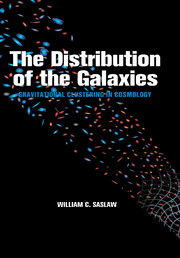Book contents
- Frontmatter
- Contents
- Prologue
- Part I Historical
- Part II Descriptions of Clustering
- Part III Gravity and Correlation Functions
- Part IV Gravity and Distribution Functions
- Part V Computer Experiments for Distribution Functions
- Part VI Observations of Distribution Functions
- Part VII Future Unfoldings
- 36 Galaxy Merging
- 37 Dark Matter Again
- 38 Initial States
- 39 Ultimate Fates
- 40 Epilogue
- Bibliography
- Index
37 - Dark Matter Again
Published online by Cambridge University Press: 19 January 2010
- Frontmatter
- Contents
- Prologue
- Part I Historical
- Part II Descriptions of Clustering
- Part III Gravity and Correlation Functions
- Part IV Gravity and Distribution Functions
- Part V Computer Experiments for Distribution Functions
- Part VI Observations of Distribution Functions
- Part VII Future Unfoldings
- 36 Galaxy Merging
- 37 Dark Matter Again
- 38 Initial States
- 39 Ultimate Fates
- 40 Epilogue
- Bibliography
- Index
Summary
No light, but rather darkness visible
MiltonHow to observe the dark matter of our Universe remains a primary puzzle of astronomy. Many searches over the radiative spectrum from radio to Xrays have uncovered much of great interest, but not enough to close the Universe. Many laboratory experiments have searched directly for exotic weakly interacting massive particles (WIMPS) streaming through space, but to no avail. Gravitational lensing of more distant sources reveals dark matter in clusters along the line of sight; its amount and detailed location are quite model dependent. So far, the main direct evidence for dark matter comes from the gravitational motions of stars within galaxies and galaxies within clusters. All of it adds up to only Ω0 ≲ 0.3. Its nature, form, and distribution still are unknown.
Close agreement between the form of the GQED and the observed spatial and velocity distributions of galaxies suggests methods for constraining dark matter. It is relatively easy to start with the cosmological many-body model and formulate dark matter variations around it. These variations should not destroy the observed agreement unduly, nor attract epicycles.
As an illustration (Fang and Saslaw, 1999), consider the peculiar velocity distribution function f(v). This is especially sensitive to local dark matter. In the simplest case, the dark matter is closely associated with each galaxy (e.g., in its halo) as it clusters, and (29.4) describes the velocities. This is consistent with observations.
- Type
- Chapter
- Information
- The Distribution of the GalaxiesGravitational Clustering in Cosmology, pp. 473 - 476Publisher: Cambridge University PressPrint publication year: 1999



